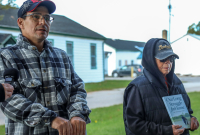Support strong Canadian climate journalism for 2025
Minna Frederick is frustrated by how unsurprising new data on bullying among sexually and gender-diverse youth in Canada is.
According to Statistics Canada data released last month, 77 per cent of sexually and gender-diverse youth aged 15 to 17 reported being bullied.
“This is an ongoing trend that has been going on for many years,” said Frederick, manager of peer support at LGBT Youth Line, a peer-to-peer helpline for LGBTQ2+ youth in Ontario.
The October data found the three most reported bullying behaviours among those surveyed were being made fun of, being excluded from activities and having rumours spread about them. In addition to bullying, 27 per cent of queer-identifying youth reported having thoughts of taking their own life, a significantly higher rate compared to other youth.
Though Frederick is glad more research is being done, the 29-year-old said it is disheartening to see the trend continues. “We need to think about support structures and what is happening beyond the level of peers because while concerning, it goes beyond youth to people like teachers who are meant to be preventing these things — they are actually participating in them at times,” Frederick said.
LGBT Youth Line offers peer support via its helpline, led by young people 29 and under. Frederick said 40 per cent of callers are under 15 while 50 per cent of callers are under 21, and they often talk about how adults act when they are made aware of identity-targeted bullying.
“There’s a lot of dismissal, adults not taking their words seriously and inaction,” Frederick said. “In a lot of cases, that bullying is coming from adults, whether that be parents or teachers. Being in that environment, the impact of bullying becomes higher when youth can’t come to people around them for support, especially when it is coming from those people of power.”
An uptick in anti-trans rhetoric also happened during Ontario’s recent municipal elections, Frederick said. “We’ve seen a trend in the last municipal election of transphobic school board trustees running and the impact that can have on youth in school when they are experiencing bullying.”
In October, CBC reported at least 20 school board trustee candidates in Ontario and nearly 30 candidates in British Columbia aligned themselves with anti-trans conservative lobby groups.
Frederick said the organized transphobia that emerged around the election is alarming, whether or not those people got elected. “The lobbying was a sign of movement of transphobia that is building and needs to be addressed.”
When adults in positions of power like parents and teachers are not talking about LGBTQ2+ people in a positive way, Frederick said the impact on LGBTQ2+ youth mental health is intensified, making it more important to create a safe environment.
“What’s happening in the public sphere, politically and in school board systems around transphobia and queerphobia, there is a lot of alarm, which puts pressure on youth,” Frederick said.
While Frederick said a lot of the statistics can be disheartening for youth to see, it’s important to balance the reality that many people are facing harm and discrimination with the strength of the community.
LGBTQ2+ youth deserve support and their concerns should be taken seriously, Frederick said. “Many of our volunteers have been there and want to be here with you through this. You deserve that support in every space you’re in.”
If you are looking for confidential and non-judgmental peer support, contact LGBT Youth Line at 1-800-268-9688 from Sunday to Friday, 4 p.m. to 9:30 p.m. ET.
Nairah Ahmed / Local Journalism Initiative / Canada’s National Observer






Comments